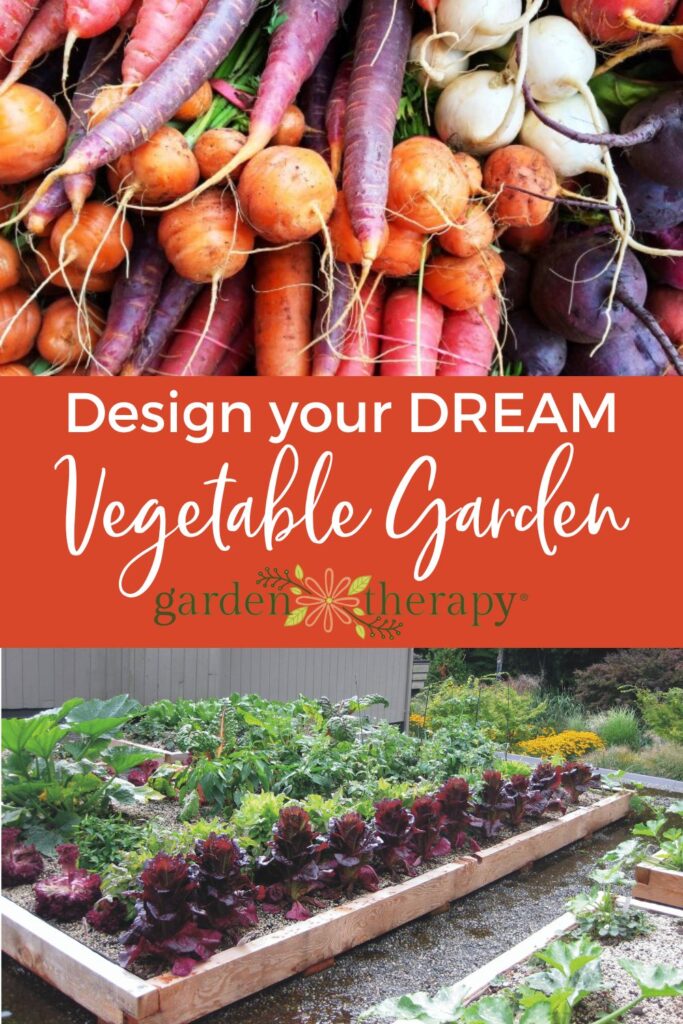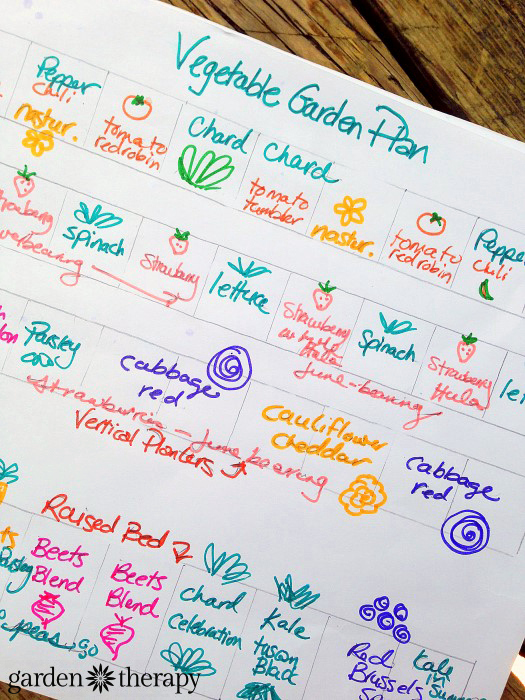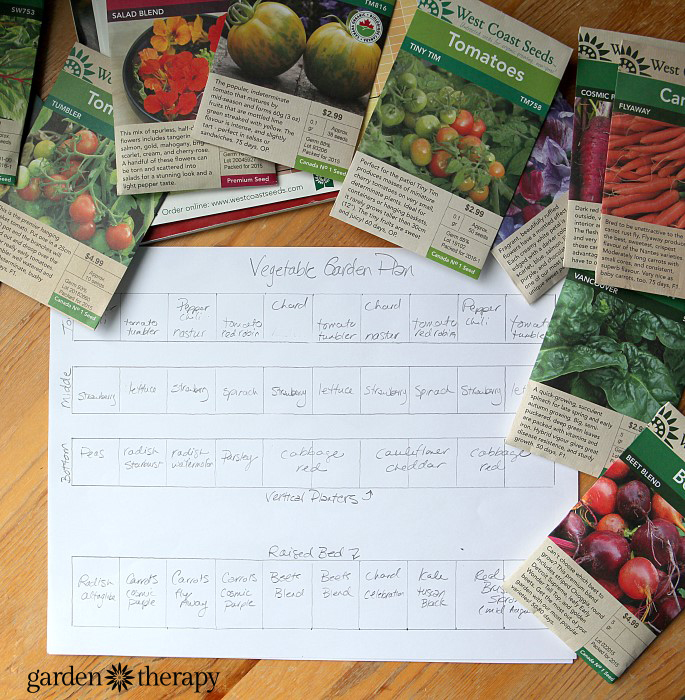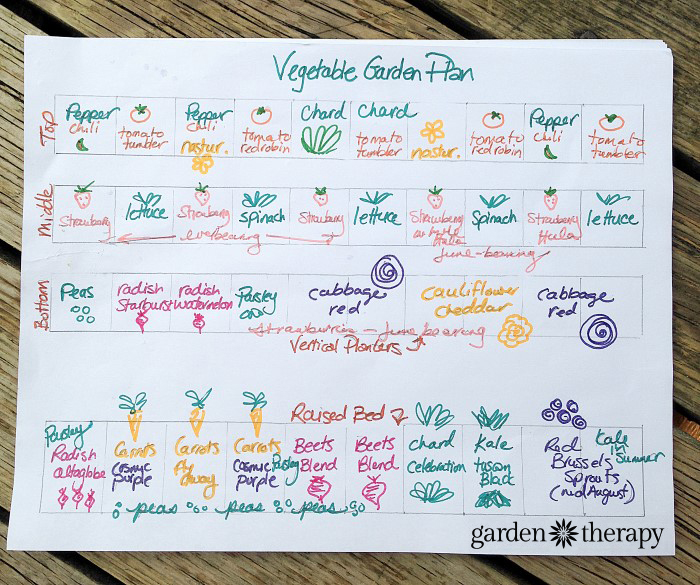If you have begun working on how to make a garden, you may feel a bit overwhelmed at the sheer amount of information, options, and how to keep track of it all. That’s where this garden map comes in handy! It’s a simple visual tool that will work for newbie gardeners and master gardeners alike.

The first step in starting a vegetable garden, or any garden really, is to write out a plan. The plan can be anything from a few Post It notes on a seed catalog to a computerized garden map.
I like to create something in between: a hand-drawn map of the garden beds with the planting plan. This garden map is a great tool to help you fully plan out your garden to maximize its space and get the best possible vegetable harvest.

Why Should I Use a Garden Map?
If you have a vegetable garden, a garden map is a must each year. It will help you determine how many seeds and plants you will need and where you should plant each of them. It also will help you keep track of what you will be producing year round and allow you to group similar harvest seasons together.
Typically, the vegetable garden needs to be planned out each year. Vegetables are annuals (for the most part) and when they reach maturity we eat them, so they need to be planted every year. Plus, each year our garden grows and changes and we need to keep up with it!
There are so many factors to where, when, and how you plant the different vegetables, that a map is the best way to keep you on track. When to start seeds, whether or not to start them outdoors, when to transplant seedlings, good plant companions, and crop rotation are all things to think about when designing a garden plan.
This is a good activity to do in late winter when you’ve got spring on the brain. I find it gets me in the gardening spirit while it is still snowy and cold outside. While it is great for vegetables, you can follow similar steps for a brand new garden or a major garden transformation. Here are the steps that I use for my mapping process.
(If you need help building garden beds then start here instead.)

How to Make a Garden Map
Ready to get started? I’ll walk you through each step so you can learn how to make a garden plan with ease!
Map Out Your Garden Space
Measure your vegetable garden and draw a garden map to scale 1″ representing 1′ in the garden. Draw in any obstacles that you will have to contend with like posts, irrigation heads, or other structures you need to work within the garden.
Label north on the map and watch the sun over the course of a few days to get a sense of what the light will be like. Remember that the sun in the summer and fall will be in different positions in the sky. Trees will leaf out and create shade, buildings may create more or less shade as the sun moves.
If this is your first year mapping your garden, make notes in a gardening journal throughout the year as to how the light will fall. Here is my garden helper coloring in the sun and shade while we plan over a coffee date.

Create Your Wish List
Grab some seed catalogs and write down all of the vegetables, fruits, and herbs that you want to grow. Now, look up each of them in a seed catalog written for your area. You may find that some of your top choices are not even for sale in your area. Sadly, this is because not every veggie can grow in every climate. You will need to stick to what you can grow, so cross those off the list.
Look at the number of days until harvest and do the math. Some vegetables need a really long growing season and if cool fall weather comes before the harvest date, you may never even taste the fruits of your labor. Think about requirements like plant size at maturity, spacing needs, and shade/sun requirements to further refine your list.
You may also be able to have multiple crops in one season! There are some speedy spring vegetables to grow for early crops as well as vegetables that can be planted later in the season. Consider grouping these vegetables together to get multiple harvests from a single area in one season.
The other thing I think about when creating my vegetable garden seed list is cost and availability of the vegetables. I choose heirloom seed varieties, rare colors, and expensive-to-buy produce to grow in my home garden.
In the winter, I also like to take an inventory of the previous season’s harvest. I look at which vegetables did well and which ones did I wish I had more of. This way I can be sure my garden is even more successful the following year when I map it out. I also note which vegetables did not perform well and see whether or not I should try and grow them again or move them to a new location.

Add Plants to Your Garden Map
Use pencil so you can easily move plants to new spaces or add more. Our vegetable garden is a small area that has four planters, two on the ground and two in the sky in a vertical planting system. To determine what plants went into the beds I looked at the location and amount of shade. I planned for root vegetables and plants with deep roots in the two beds that are on the ground. Shallow rooted plants when in the upper planters. I also make sure to note vertical vegetables such as tomatoes or peas. They will need additional support and may eventually cause shade to lower growing plants later in the season.
Finally, put pen to paper and mark the final location of your vegetables. This plan may change as the season goes by. Mark those changes, and anything that you noticed throughout the year right on your garden map. It will be a great starting point for next year, and a memento of your garden for years to come.
Make sure you put your map somewhere for safe keeping. Make notes on what worked and what didn’t work so you can plan again better next year. Saving your map for future reference can be an immense help!

Garden Map Tips
When mapping, I like to use square foot gardening. If you have uniquely-shaped garden beds like I do, then square foot planting will be a very helpful tool. Mark each square foot on the garden map, then you can determine how many plants of each type can go in each square. Some vegetables like cabbage and cauliflower require at least a square to themselves, but others like carrots can squeeze 12-16 plants into a square. There is a guide here for square foot planting.
That being said, get creative with your space! As I mentioned earlier, I primarily grow my vegetables in pots and containers and my unique vertical garden. Don’t just think of traditional vegetable beds. Anyone can benefit from a garden map, especially those with small and uniquely shaped gardens.
You may also want to consider crop rotation for your garden. Plants that belong to the same family tend to use the same nutrients in the soil. Planting the same vegetables year after year in the same area can deplete the soil. Similar plant families include alliums, Solanaceae, brassica, cucurbit, and legume families. When doing your planting research, make a note of what family it belongs to. Keeping your map is especially helpful in keeping track of crop rotation year after year.





wonderful design. Step by step design is great. I love hearing about good people that live in balance with nature! Thank you for sharing.
This would make a great small paper back book. We’d gift them out to friends!!!